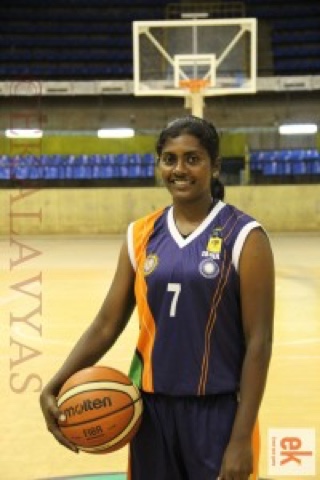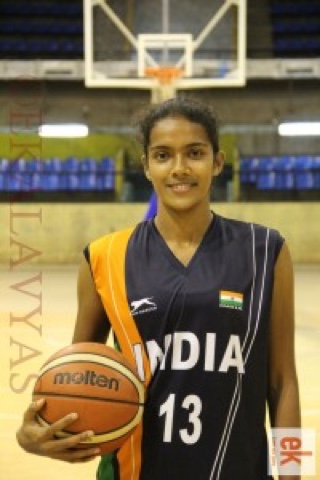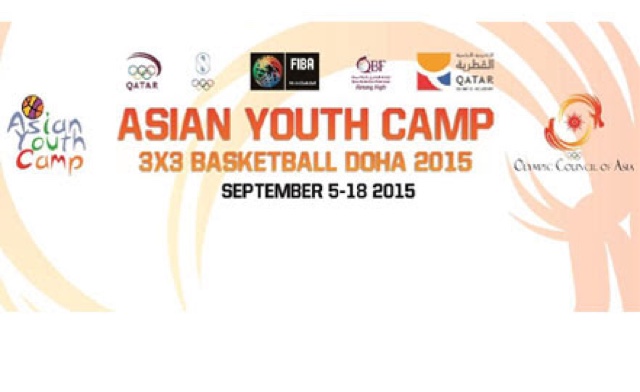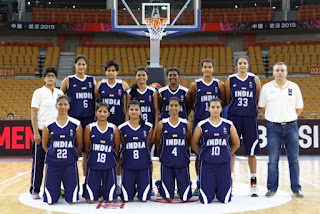ShareThis
India’s Women’s basketball team faces a daunting future without their greatest-ever star, Geethu Anna Jose
This feature was first published in my column for Ekalavyas on August 29, 2015. Click here to read the original article.
At 19, by the time she first donned the India jersey for the senior national team, Geethu Anna Jose – born and (mostly) bred in Kerala – was already a rising star. Standing 6-foot-2, Geethu would automatically become the center of attention anytime she took the floor. Teammates looked to her in awe and opponents in fear. She was shy and soft-spoken off the court, but on it, she turned into a fierce competitor whose game spoke much louder than words.
When Geethu was first selected to represent Team India at the 2004 FIBA Asia Basketball Championship (ABC) for Women – the highest level of competition that India’s teams participate in – the country was facing a continued lull in their international performances. India hadn’t finished in the top six (Level 1) stage of the biennial championship since 1992. They were in desperate need of inspiration and leadership.
In Geethu – and the generation of young players who joined the game around the same time as her – they found the perfect anchor to build around. Little would she know that, a decade later, her tall frame would overshadow and dominate Indian basketball like none before.
Over the next ten years, Geethu achieved as much as any player – male or female – in Indian basketball history, and then some. She became a regular for India at the FIBA ABCs, playing a major role for India every time they set off to face the continent’s best. At the 2006 Commonwealth Games in Australia, she finished as the basketball tournament’s MVP, leading scorer, leading rebounder, and leading shot-blocker. In 2009, Chennai hosted the FIBA ABC, and Geethu was named India’s captain. Making the most of the home court inspiration, she helped India return to Level 1 with a sixth-place finish and ended as the tournament’s top scorer. She has played for India at the Asian Games, the Stankovic Cup, and helped the country achieve excellent results in the 3×3 version of the game, even winning the
gold medal at the FIBA Asia 3×3 Basketball Championship in Qatar.
Back home, at every domestic tournament, there was Geethu and then there was everyone else. From 2004-05 onwards, Geethu helped make the Indian Railways team into an unstoppable machine, winning the Senior National championship for nine consecutive years until 2013.
Eventually, she gained international success unlike any Indian player, too. Geethu became the first Indian player to play professionally in Australia, representing the Ringwood Hawks for a few years, where she won MVP of the Big V division and was selected by the WNBL. In 2011, she made history by receiving invitations to
tryout for three WNBA teams: the Chicago Sky, Los Angeles Sparks, and San Antonio Silver Stars. She and her Indian Railways teammate Anitha Paul Durai also played a season
professionally in Thailand.
Last year, Geethu received one of the highest honours given to Indian sports-persons –
the Arjuna Award – for her services and contribution to Indian basketball. It was the culmination of a career of hard work and excellence.
But to many, it seemed like the concluding exclamation to the career itself. After being part of India’s 2013 FIBA ABC team – the squad who finished at a best-ever fifth-place in Thailand – Geethu took some time off the game to focus on her personal life. Since then, the 30-year-old has been married and become a mother. While basketball hasn’t completely disappeared from her periphery, it does seem to be fading further and further into the horizon.
Now, for the first time in over a decade, the post-Geethu era begins for Team India. Coached by the Spaniard Francisco Garcia, the
new 12-member squad heads to the 2015 FIBA ABC. The tournament is set to be held in Wuhan (China) from August 29 to September 5 and Garcia faces the unenviable task of leading a team with limited practice, limited international exposure, and without Geethu, who was the pillar keeping the Indian flag waving high for years.
When I contacted her about watching the team set out to this big challenge in her absence, Geethu seemed to be sceptical – but eventually optimistic – of the girls’ chances.
“We need to wait and watch,” Geethu said, “But personally, I want them to do well. I always believe and tell my teammates that dependency on any one player is not the right thing for the game.”
“There are many players who have the capability to rise to that level,” she said on the question of who can be the next star for India after her, “But what I have seen recently is that many players aren’t pursuing their dreams, and instead are fading away into personal commitments. They are leaving their game at sea. It takes tremendous sacrifices with perseverance, commitment and hard-work to mould yourself to be the best of the best players.”
Geethu’s absence will create two major voids for India: in leadership and in size. But every crisis presents an opportunity. Coach Garcia will be hoping that the baton is smoothly passed on to Anitha Paul Durai as India’s new leader on the court, and a rush of other younger talents can develop their own games to rise without Jose’s presence inside.
The Coach: Francisco Garcia
 |
| Photo Courtesy: Ekalavyas |
“We have to substitute [Geethu] especially in defence by trying to front the post players and playing as physically as we can,” Garcia said, “Obviously, we cannot play the same way; in Bangkok, we were playing with a lot of options for her in the inside game, but right now, we don’t have that option. So, we have to play many pick-and-roll options, penetrations, and kicking to the outside players.”
“I think she was, together with Anitha, the main players in India. She was dominating in India and FIBA Asia Championships. If you ask teams outside of India who are the most popular players, they will say Geethu. For us it’s a big loss. We don’t have a substitute for her right now. But, we have to try to substitute her loss with other things.”
“Right now, one the most important players that we have is Kavita Akula. Of course Anitha is bringing experience for the team, but she was out of the game for a year. You can feel on the court that she is not in the best shape. And Jeena PS and Shireen Limaye are probably the next one who are on the ‘good’ level.”
I spoke to a trio of players expected to be India’s flag-bearers in Wuhan – Anitha Paul Durai, Shireen Limaye, and Jeena PS – on their expectations for the FIBA Women’s ABC.
The Veteran: Anitha Paul Durai
 |
| Photo Courtesy: Ekalavyas |
If Geethu is the Alpha, Anitha is Omega. The Chennai-born wing player has played by Geethu’s side for Indian Railways, professionally in Thailand, and for the Indian national team for a decade. Like Geethu, Anitha also took a short exile from the game for family reasons. A little over a year after giving birth to her first child, she returns to action for India as the current team’s most-experienced and accomplished player.
“Geethu and I played together from 2004 to 2013,” Anitha said, “We have had good understanding between each other. She is so strong in the center; in past ABCs, when our team would be down, she would look at me and I would gain confidence from her eyes!”
“Going into this tournament, we’ve only had 40 days of camp, and it’s not enough. But still, we are working hard to maintain our fifth position in Asia. I am the only senior and more experienced player, so I have to be very much responsible for my team, so they can give a better performance and keep working hard.”
“This is going to be our first ABC in many years without Geethu. I am really proud of myself that I was able to return to Team India after my delivery and play at the ABC. The team is good. Our junior players are strong, the only thing lacking is the experience, which Geethu had. For now, I am very happy that my juniors are hearing my words and cooperating with me on court.”
The All Rounder: Shireen Limaye
 |
| Photo Courtesy: Ekalavyas |
Still only 20, Pune’s Shireen Limaye has already been an integral part of Team India for about five years, peaking as a young prodigy and eventually making a steady place for herself in the senior team. Limaye is an all-round talent capable of dominating on all ends of the floor. She is attempting a comeback to the team at the ABC after a major knee injury.
“Geethu of course has probably meant the most to this team,” Limaye said, “Geethu and Anitha have played a very pivotal role for India’s Women’s team over the years. A post player like Geethu will be missed in this tournament by us.”
“My responsibilities right now are to help the team with rebounding and assists, and score important points in the big moments. I need to bridge the gap between our young team and Geethu.”
“I’m confident about the team and that we will perform as per expectations. The team is playing well together. We had a good preparatory camp but it was of very short duration. We will be giving our best shot to retain our position. I am sure Coach Garcia will help us to perform at our 100 percent and deliver positive results.”
The Heir: Jeena PS
 |
| Photo Courtesy: Ekalavyas |
Hailing from Geethu Anna Jose’s home-state of Kerala, Jeena Scaria PS is in many ways the heir to the throne and one of the future stars of Indian basketball. With experience in several major international tournaments, the 21-year-old has already turned future potential into present dominance. Without Geethu in the lineup, there will be greater pressure on Jeena to take a bigger role in the team.
“Everyone knows that Geethu is a superb player. She was the pillar of the Indian team for the last few years. She was awesome in defence as well as in offense, and she used to help the other four players on both ends. Whenever she was on court, everyone would feel confident. She led the team in rebounds, scoring, and helped the most on defence. She used to teach me too about my awareness and movement on both ends. I am sure that we will miss her on the court.”
“This time we have a young team, but we have Anitha who is well experienced and has represented India many times. Our other forwards like Shireen, Poojamol KS, Anjana PG, and Sitamani Tudu are also good: both in their outside shooting range and in penetrating inside, too. Our post players: Rajapriyadarshini, Stephy Nixon, Smruthi Radhakrishnan, and Apporva Muralinath will be trying their best to compensate Geethu’s absence. Ball handlers Kavita Akula and Bhandavya HM are leading the team perfectly. Our coaches are doing a good job guiding our team. I’m not gonna say that we will win the title, but still, I am sure that we will work hard and play tough. We hope we can stay in the upper pool.”
The Legend: Geethu Anna Jose
While the rest of the women take the court bravely this week to prove that they are capable of carrying India without Geethu, the legend herself hasn’t yet completely shut the door on a comeback to the game.
“Basketball is a passion to me, closely knitted to my heart,” Geethu said, “For any woman it takes good effort to come back to active sport after giving birth. But in recent times many players such as my good friend and colleague Anitha Paul Durai proved that with a set goal in mind, you can indeed return to active sport within few months of delivery.”
“I do believe that I have some more years which I can offer to my country and the game.”
For 10 years, Geethu helped Team India aim higher and stand with their heads up high against every competition. In the long term, she may yet return to boost the team again; but for now, India’s biggest question will be how they can rise even higher without her.
ShareThis Copy and Paste
ShareThis Copy and Paste































